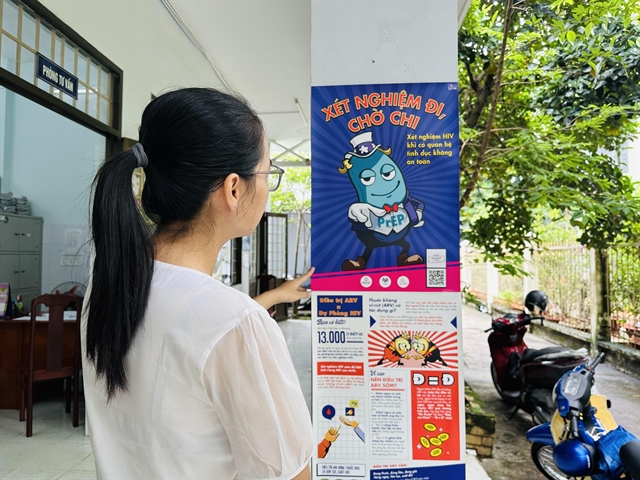 Society
Society

 |
| A man is tested for HIV at the Centre for Disease Control in Kiên Giang Province. — Photo vietnamplus.vn |
KIÊN GIANG — Projects fighting the HIV epidemic in the Mekong Delta province of Kiên Giang have achieved significant results as the rate of HIV-infected people being diagnosed and treated on the same day has increased sharply.
The CDC-supported Meeting Targets and Maintaining Epidemic Control (EPIC) provides strategic technical assistance and direct service delivery to achieve control of the HIV epidemic and promote self-reliant management of national HIV programmes by improving HIV case finding, prevention, treatment programming and viral-load suppression.
According to the report from the provincial Centre for Disease Control (CDC), this locality ranks fourth among the provinces in the Mekong Delta region and sixteenth nationwide in terms of the number of detected HIV-infected people. Annually, Kiên Giang identifies an additional 350-400 HIV infections. In 2022, 469 cases were detected.
Doctor Giang Văn Tiên from the CDC's HIV/AIDS department said the implementation of activities related to public health response and HIV case monitoring within the framework of the EpiC project has brought significant effectiveness to the province's epidemic prevention and control efforts, particularly focusing on the group of men who have sex with men (MSM).
The project is currently being implemented in Rạch Giá City, Châu Thành and Phú Quốc districts.
The establishment of HIV confirmatory testing centres at the locations where the project is being implemented has made a significant contribution to the timely detection and treatment of patients.
Over 50 per cent of patients receive treatment on the same day, and the success rate in HIV treatment exceeds 90 per cent, Tiên said.
According to Doctor Võ Thị Lợt, deputy director of the Kiên Giang CDC, the EPIC project has been implemented in Phú Quốc District since the beginning of this year.
Phú Quốc is considered a complex location with high rate of HIV infection because most of the HIV-infected patients in the MSM group come from other places, and healthcare workers face challenges in accessing them.
In the first six months of the year, Phú Quốc District detected 31 new infections out of a total of 300 cases in the entire province. Since January, 25 cases (accounting for 75 per cent) received HIV treatment on the same day as the confirmatory test results. Furthermore, the entire number of cases received HIV treatment within seven days after detection.
Among the newly recorded HIV cases in the province, approximately 50 per cent are attributed to the MSM group. The HIV cases in the MSM group are also getting younger.
Specifically, in three localities where the project is implemented, MSM cases account for 59 per cent of new HIV infections.
The province now has nine clinics that provide antiretroviral therapy (ARV) for HIV-infected people. Many people who have tested positive have received immediate treatment with ARV on the same day.
 |
| The establishment of HIV confirmatory testing centres at the locations where the project is being implemented has made a significant contribution to the timely detection and treatment of patients. |
The EPIC project aims to achieve the goal of reducing the HIV infection rate in the general population to below 0.3 per cent, achieving the 90-90-90 targets (90 per cent of all people living with HIV know their disease status, 90 per cent of all people with diagnosed HIV infection receive sustained antiretroviral therapy, and 90 per cent of all people receiving antiretroviral therapy will have viral suppression), and working towards effectively ending the AIDS epidemic in Việt Nam by 2030.
This year, the project will focus on community and healthcare facility case finding; HIV/AIDS care and treatment; pre-exposure prophylaxis (PrEP) for HIV exposure prevention; enhancing the quality of testing facilities; monitoring, evaluation, and supervision; strengthening the capacity of the healthcare system (HSS); public health response; social contracting; and technical support to provincial facilities.
As of June 30, the province has accumulated a total of 6,509 HIV cases, of which 1,702 have died.
About 3,160 patients receive sustainable anti-virus (ARV) treatments, including 74 children under 15 years old.
The high-risk groups are individuals engaged in same-gender sexual activity, injecting drug users, and sex workers.
According to statistics, 81 per cent of HIV infections were transmitted through sexual contact.
In terms of age distribution, people aged 25-49 account for 72 per cent of cases, and among the genders, 66 per cent are male and 34 per cent are female.
From 2017 to now, there has been an increasing trend in newly diagnosed HIV cases among males, reaching 86 per cent in 2022.
In recent years, the group with the highest risk of HIV infection is the group of men who have sex with men, with HIV infection rates ranging from 11.3 per cent to 14.7 per cent based on surveillance data from 2015 to 2020.
In 2022, the infection rate tends to decrease but remains high at 11.3 per cent.
The current HIV prevalence rate in Kiên Giang Province is approximately 0.2 per cent, which is lower than the national rate of 0.3 per cent.
Additionally, 99.3 per cent of communes and wards in the province have reported cases of HIV infection.
According to the deputy director of the provincial CDC, Kiên Giang is implementing various activities in HIV/AIDS prevention and control, including harm reduction interventions, HIV infection prevention, counselling and HIV testing services, management and treatment of drug addiction using Methadone substitution therapy, pre-exposure prophylaxis (PrEP) for HIV prevention, antiretroviral therapy for HIV treatment, and treatment for individuals co-infected with HIV and hepatitis C virus.
Doctor Lợt said a major difficulty in HIV/AIDS prevention and control in the province is the continuous increase in the number of new infections.
Currently, the entire province has 4,000 cases of people living with HIV/AIDS who require continuous and lifelong care and treatment. However, there are no specific regulations regarding the funding level for HIV/AIDS prevention and control activities. As a result, healthcare facilities have not been able to implement the procurement of supplies for HIV testing.
Most of the supplies for HIV testing have been given by external projects, she said. — VNS




